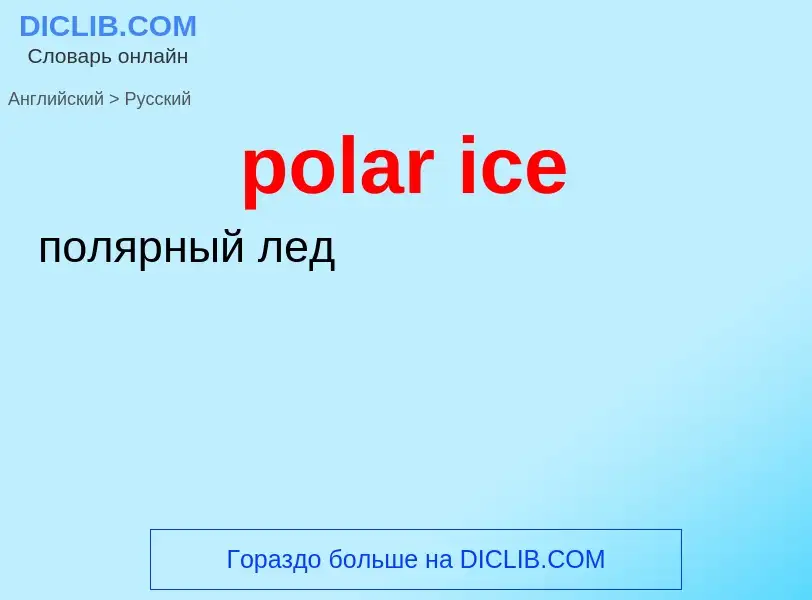Μετάφραση και ανάλυση λέξεων από την τεχνητή νοημοσύνη ChatGPT
Σε αυτήν τη σελίδα μπορείτε να λάβετε μια λεπτομερή ανάλυση μιας λέξης ή μιας φράσης, η οποία δημιουργήθηκε χρησιμοποιώντας το ChatGPT, την καλύτερη τεχνολογία τεχνητής νοημοσύνης μέχρι σήμερα:
- πώς χρησιμοποιείται η λέξη
- συχνότητα χρήσης
- χρησιμοποιείται πιο συχνά στον προφορικό ή γραπτό λόγο
- επιλογές μετάφρασης λέξεων
- παραδείγματα χρήσης (πολλές φράσεις με μετάφραση)
- ετυμολογία
polar ice - translation to ρωσικά
['aisdrift]
общая лексика
дрейф льда
плавучие льды
торосы
нагромождение плавучего льда
ледяные поля
Ορισμός
Βικιπαίδεια

A polar ice cap or polar cap is a high-latitude region of a planet, dwarf planet, or natural satellite that is covered in ice.
There are no requirements with respect to size or composition for a body of ice to be termed a polar ice cap, nor any geological requirement for it to be over land, but only that it must be a body of solid phase matter in the polar region. This causes the term "polar ice cap" to be something of a misnomer, as the term ice cap itself is applied more narrowly to bodies that are over land, and cover less than 50,000 km2: larger bodies are referred to as ice sheets.
The composition of the ice will vary. For example, Earth's polar caps are mainly water ice, whereas Mars's polar ice caps are a mixture of solid carbon dioxide and water ice.
Polar ice caps form because high-latitude regions receive less energy in the form of solar radiation from the Sun than equatorial regions, resulting in lower surface temperatures.
Earth's polar caps have changed dramatically over the last 12,000 years. Seasonal variations of the ice caps takes place due to varied solar energy absorption as the planet or moon revolves around the Sun. Additionally, in geologic time scales, the ice caps may grow or shrink due to climate change.



![[[Mars]]'s north polar region with ice cap, composite of [[Viking 1]] orbiter images (Courtesy [[NASA]]/[[JPL]]-Caltech) [[Mars]]'s north polar region with ice cap, composite of [[Viking 1]] orbiter images (Courtesy [[NASA]]/[[JPL]]-Caltech)](https://commons.wikimedia.org/wiki/Special:FilePath/Mars NPArea-PIA00161.jpg?width=200)



![''[[The Blue Marble]]'', Earth as seen from [[Apollo 17]] with the southern polar ice cap visible (courtesy [[NASA]]) ''[[The Blue Marble]]'', Earth as seen from [[Apollo 17]] with the southern polar ice cap visible (courtesy [[NASA]])](https://commons.wikimedia.org/wiki/Special:FilePath/The Earth seen from Apollo 17.jpg?width=200)

![Rare phenomenon – the formation of ball ice. Stroomi Beach, [[Tallinn]], [[Estonia]]. Rare phenomenon – the formation of ball ice. Stroomi Beach, [[Tallinn]], [[Estonia]].](https://commons.wikimedia.org/wiki/Special:FilePath/Jää on kulmunud pallideks (Looduse veidrused). 05.jpg?width=200)
![As ice melts, the liquid water collects in depressions on the surface and deepens them, forming these melt ponds in the [[Arctic]]. These fresh water ponds are separated from the salty sea below and around it, until breaks in the ice merge the two. As ice melts, the liquid water collects in depressions on the surface and deepens them, forming these melt ponds in the [[Arctic]]. These fresh water ponds are separated from the salty sea below and around it, until breaks in the ice merge the two.](https://commons.wikimedia.org/wiki/Special:FilePath/Ponds on the Ocean, ICESCAPE.jpg?width=200)
![Satellite image of sea ice forming near [[St. Matthew Island]] in the Bering Sea Satellite image of sea ice forming near [[St. Matthew Island]] in the Bering Sea](https://commons.wikimedia.org/wiki/Special:FilePath/Seaice.jpg?width=200)
![lead]]s. (Scale not available.) lead]]s. (Scale not available.)](https://commons.wikimedia.org/wiki/Special:FilePath/Sea ice near coast of Labrador -a.jpg?width=200)
![lead]] developing in the centre.(Scale not available.) lead]] developing in the centre.(Scale not available.)](https://commons.wikimedia.org/wiki/Special:FilePath/Ikaasaartik-strait-icefloes-aerial.jpg?width=200)



![Sea ice off [[Baffin Island]] Sea ice off [[Baffin Island]]](https://commons.wikimedia.org/wiki/Special:FilePath/Sea Ice off Baffin Island.jpg?width=200)
![Sea ice imitates the shoreline along the [[Kamchatka Peninsula]]. Sea ice imitates the shoreline along the [[Kamchatka Peninsula]].](https://commons.wikimedia.org/wiki/Special:FilePath/Sea Ice Imitates the Shoreline along the Kamchatka Peninsula.jpg?width=200)
![Clear view of the [[Antarctic Peninsula]], the [[Larsen Ice Shelf]] and the sea ice-covered waters around the region Clear view of the [[Antarctic Peninsula]], the [[Larsen Ice Shelf]] and the sea ice-covered waters around the region](https://commons.wikimedia.org/wiki/Special:FilePath/Antarctic Peninsula, the Larsen Ice Shelf, and the sea ice covered waters around the region.jpg?width=200)
